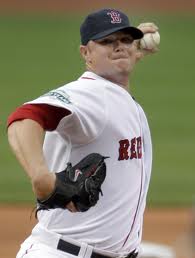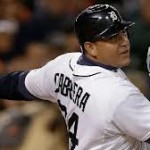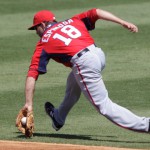Love it; another inbox to analyze. In the wake of the Scherzer signing, lets see what kind of questions MLB.com beat reporter Bill Ladson fielded this week.
As always, I answer as I write before reading Ladson’s answer, and edit questions for clarity as needed.
Q: How much better will the Nationals be now that right-hander Max Scherzer is on the roster?
A: Well, if you play the “WAR analysis” game, then Max Scherzer replaces Tanner Roark in the rotation for 2015. Scherzer posted a bWAR of 5.5 in 2014 while Roark posted a bWAR of 4.8. So on the face of it, assuming that both players provide identical value in 2015 as they did in 2014, perhaps Scherzer won’t immediately impact the team. This is the essence of those immediate-post signing blogs and columns that questioned why the Nats needed to make this acquisition.
However. I offer some counters.
- Roark immediately becomes your spot-starter to cover for injury. Lets say that Gio Gonzalez (bWAR in 2014 of just 2.1) gets hurt and Roark covers for him; well that’s nearly a 3-WAR improvement. Certainly Roark is going to be better than whatever AAA cover we could promote to provide injury relief. The Nats only gave
1213 starts to non-core rotation guys in 2014 but more than twice that number in 2013; the odds are that an injury is going to hit the rotation at some point. - Scherzer will be better in 2015 than he was in 2014. Why? He moves to the NL, gets to face pitchers instead of DHs, faces generally weaker lineups, plays in a weaker division and pitches in more parks that are pitcher friendly. You can make the argument that his K/9 is going to increase significantly (if he faces the pitcher 60-70 times in a season, he likely strikes them out at least half of that), and his ERA likely falls at least a half a point. That will boost his WAR for 2015.
- Scherzer going twice in a seven game playoff series is going to be better than having any one else getting that second start. In fact, a 1-2-3 punch of Strasburg, Zimmermann and Scherzer is one heck of a daunting task for any opponent.
- And there’s this: not to completely re-hash my post on the Scherzer signing, but i’ll note that this signing (to me) seems like a way to bridge the gap and guarantee an “Ace” in the rotation through the next two off-seasons of rotation transition (where the team likely loses Zimmermann, Fister and Strasburg). The Nats rotation looks an awful lot better after these three guys are gone if Scherzer is leading the line. So to me this isn’t a move about 2015 as much as it is about getting this team to 2017 and maintaining competitiveness.
Ladson said very little about answer the question, using his answer to immediately talk about the offense and the bench. Yeah we know there’s issues there. And we all remember how the middle of the order went like 1-for-the NLDS. Wasn’t the question.
Q: Why didn’t Espinosa work on hitting right-handed exclusively after the season ended? If Espinosa made that transition successfully, he would be the answer at second base.
A: A good question. Not the first time this topic has come up. We’ve discussed it to death here but the reasons seem to fall along the following:
- Espinosa may be getting “advice” from his agent (Scott Boras) to put his own interests first.
- Espinosa may be “stubborn” about maintaining his switch hitting, given that it is a differentiator in the marketplace for him.
- Espinsoa may just be uneasy about suddenly facing right-handed curve balls from the right-hand side, probably having not faced such a situation in more than a decade (a fair point).
We all know about his splits lefty versus righty. We all know he has not chosen to try RH-only. I think its also safe to say that the organization has gone out of its way (Asdrubal Cabrera last season and now Yunel Escobar) to replace him in the starting lineup despite his defensive skills. It is what it is; we now have a backup infielder on the roster to cover both 2B and SS and who has some pop from the plate in a backup capacity (and the associated K-rate of course). Not the worst thing in the world to have. Ladson says … well he stated the obvious (Escobar is the starter) and then says that the “Nats hope Espinosa cuts down on his strike-outs.” Non-answer.
Q: How come Jeff Kobernus is not being considered for the starting second-base job? Why not have a young, cost-controlled guy play every day?
A: Because Kobernus hasn’t played 2B basically since college full-time since a half-season stint in Harrisburg in 2012. The team moved him to the OF and he’s mostly stayed there. Even if you thought he could play second effectively, he’s got a career minor league slash line of .285/.331/.363. He is what he is: a utility guy who can cover in case of a slew of injuries and makes for a good 9/1 pinch running/6th outfielder call-up, but that’s about it. I don’t think you can count on him to produce at the major league level day-in and day-out. Ladson says Kobernus has a chance of making the bench out of spring training this year, which I disagree with.
Q: Asdrubal Cabrera signed with the Rays for one-year, $7.5 million. Why couldn’t the Nats make that deal? Or something close to it?
A: Probably because Cabrera wanted to play short-stop, and the Nats have a short-stop. Besides, Escobar at $5M is a good deal. I mentioned at some point in the off-season that Cabrera’s offensive output with Washington wasn’t too much better than Espinosa’s frankly (Cabrera’s split line with Washington in 2014 was .229/.312/.389; Escobar brings more to the table. Ladson agrees, and says that the Nats weren’t willing to bring Cabrera back at his asking price based on what he showed last year.
Q: Why didn’t the Nats consider Tyler Clippard as their closer?
A: Hmm. Good question. Perhaps because when Clippard was given the closer job in 2012, he really struggled with it as compared to his typical 8th inning performance. ERA in 2012 as closer: 3.72. Career ERA: 2.88. Besides, there was more in play for Clippard’s trade than just who was going to be the 2015 closer. Clippard’s got a ton of miles on his arm, Clippard was set to make nearly 8 figures as a reliever, and the Nats felt like they could afford to part ways with him to acquire a player who filled a need. Ladson notes what I noted, and said that Clippard’s pending free agency played into the decision. That’s a great point that I didn’t mention; Clippard wasn’t going to be offered a qualifying offer (likely worth $16M next off-season), so he’d depart to no compensation. With this trade, the Nats got some compensation for him.
Q: I know he’s had plenty of success as a general manager, but I’m surprised Mike Rizzo doesn’t feel any sense of urgency to try to sign Desmond or Jordan Zimmermann to an extension. What are your thoughts on this?
A: I think Mike Rizzo has been trying to extend these guys for more than two years. “Sense of urgency?” What else do you want to ask of the guy? He by all accounts has offered both guys 9-figure deals, and has been rebuffed. Do you think Ian Desmond is worth a 7yr/$100M deal? Do you think Zimmermann is worth a 6yr/$150M deal? Clearly to me the two players are valuing themselves higher than what the GM is valuing them, the GM has made what he thinks to be fair market value deals, and both guys have opted to test the market. Baseball is a business, both on the player side and the team side. Ladson thinks Rizzo will step up discussions once spring training happens. I don’t; I think that the ship has more or less sailed on extending these guys at this point. Now, will the team move Zimmermann? I think we may see offers once James Shields signs…. if there’s teams out there that want to improve but miss out on Shields, they may come calling to the Nats with deals we cannot turn down. We’ll see. Overall thougth I’m doubtful any trades occur at this point. My prediction: the juggernaut rotation goes into 2015 in-tact.







